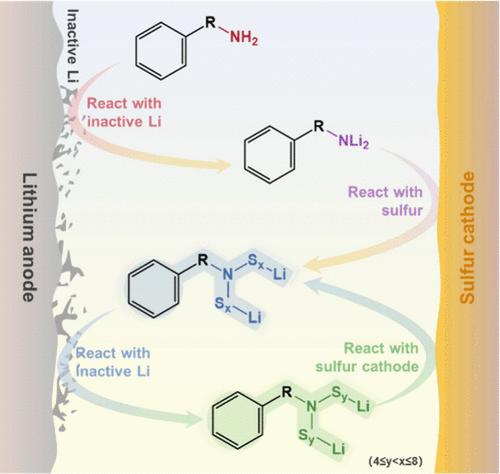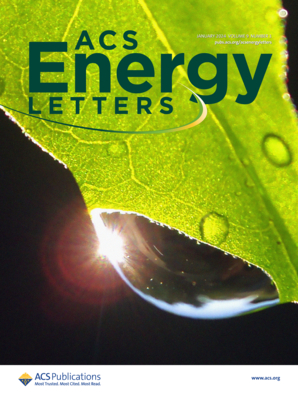通过重新激活非活性锂来实现长循环锂硫电池
IF 18.2
1区 材料科学
Q1 CHEMISTRY, PHYSICAL
引用次数: 0
摘要
高能量密度的锂硫(Li-S)电池很有吸引力,但循环寿命短却阻碍了它的发展。非活性锂的形成和积累会降低电池的稳定性。在此,我们提出了一种苯乙胺(PEA)添加剂,用于在不影响电池库仑效率(CE)的情况下,重新激活锂-硫电解质(EPSE)锂-S 电池中的非活性锂。PEA 与非活性锂发生反应,在阳极侧形成还原态的有机多硫化物 R-LiPEA,随后与 S 阴极反应生成氧化态的 O-LiPEA。R-LiPEA 和 O-LiPEA 进行氧化还原循环,以重新激活电池中积累的非活性锂。与基于不含 PEA 的 EPSE 的 122 次循环相比,在 EPSE 中添加了 PEA 的锂-S 电池在苛刻条件下可实现 185 次循环,并且与不含 PEA 的 93% 相比,含 PEA 的电池可保持较高的 CE 值(96%)。这项工作阐明了氨基添加剂的巧妙改性,通过有机多硫化物氧化还原机制重新激活非活性锂,用于先进的锂-S 电池。本文章由计算机程序翻译,如有差异,请以英文原文为准。

Long-Cycling Lithium–Sulfur Batteries Enabled by Reactivating Inactive Lithium
High-energy-density lithium–sulfur (Li–S) batteries are attractive but hindered by short cycle life. The formation and accumulation of inactive Li deteriorate the battery stability. Herein, a phenethylamine (PEA) additive is proposed to reactivate inactive Li in Li–S batteries with encapsulating lithium-polysulfide electrolytes (EPSE) without sacrificing the battery Coulombic efficiency (CE). PEA undergoes reactions with inactive Li to form organic polysulfide R-LiPEA in a reduction state at the anode side and subsequently reacts with the S cathode to generate O-LiPEA in an oxidation state. R-LiPEA and O-LiPEA engage in redox cycles to reactivate inactive Li that accumulates in batteries. Compared with 122 cycles based on EPSE without PEA, Li–S batteries with PEA additive in EPSE achieve 185 cycles under demanding conditions and maintain higher CE of 96% with PEA than 93% without PEA. This work elucidates the ingenious modification of amino-based additives to reactivate inactive Li by an organic polysulfide redox mechanism for advanced Li–S batteries.
求助全文
通过发布文献求助,成功后即可免费获取论文全文。
去求助
来源期刊

ACS Energy Letters
Energy-Renewable Energy, Sustainability and the Environment
CiteScore
31.20
自引率
5.00%
发文量
469
审稿时长
1 months
期刊介绍:
ACS Energy Letters is a monthly journal that publishes papers reporting new scientific advances in energy research. The journal focuses on topics that are of interest to scientists working in the fundamental and applied sciences. Rapid publication is a central criterion for acceptance, and the journal is known for its quick publication times, with an average of 4-6 weeks from submission to web publication in As Soon As Publishable format.
ACS Energy Letters is ranked as the number one journal in the Web of Science Electrochemistry category. It also ranks within the top 10 journals for Physical Chemistry, Energy & Fuels, and Nanoscience & Nanotechnology.
The journal offers several types of articles, including Letters, Energy Express, Perspectives, Reviews, Editorials, Viewpoints and Energy Focus. Additionally, authors have the option to submit videos that summarize or support the information presented in a Perspective or Review article, which can be highlighted on the journal's website. ACS Energy Letters is abstracted and indexed in Chemical Abstracts Service/SciFinder, EBSCO-summon, PubMed, Web of Science, Scopus and Portico.
 求助内容:
求助内容: 应助结果提醒方式:
应助结果提醒方式:


